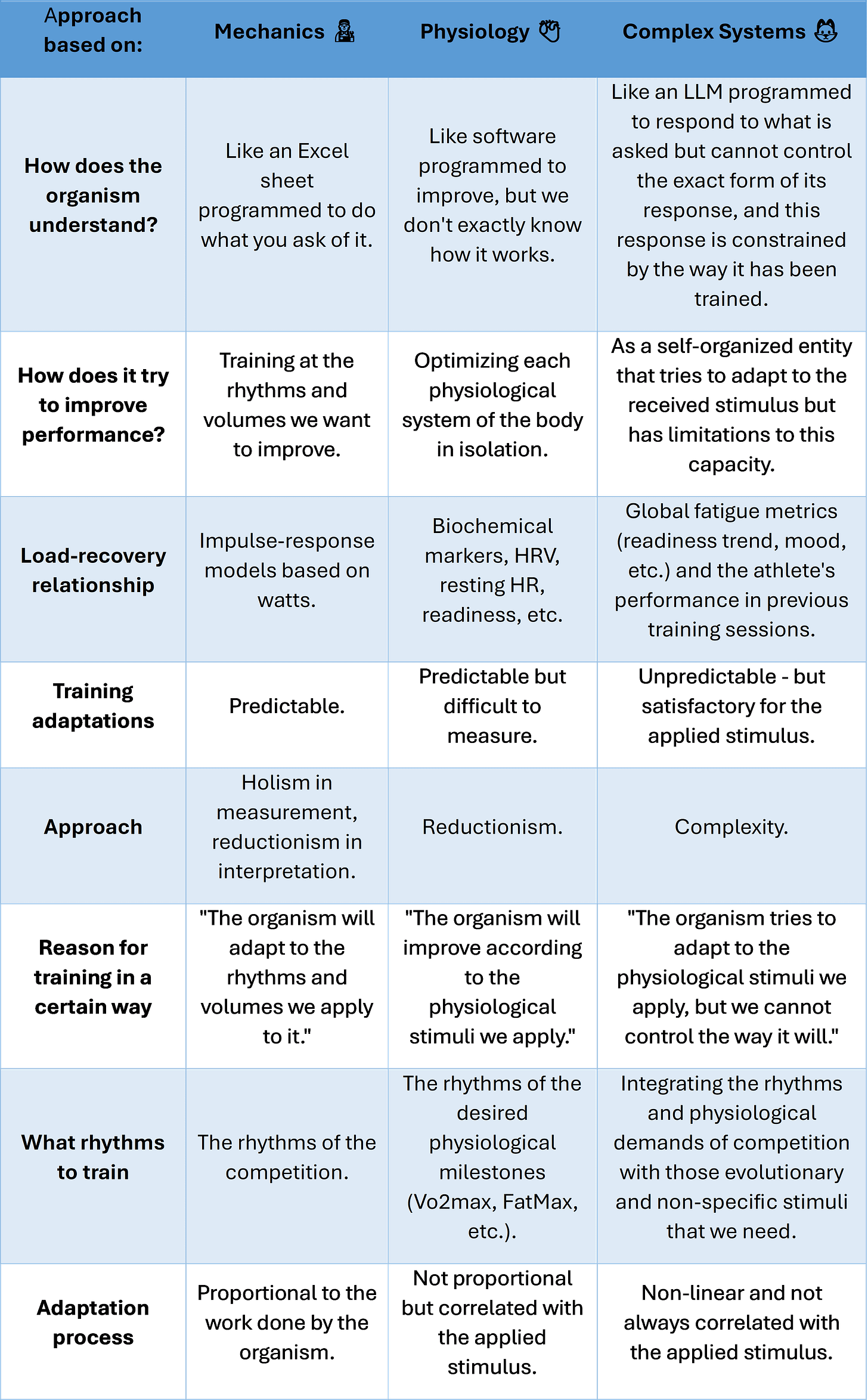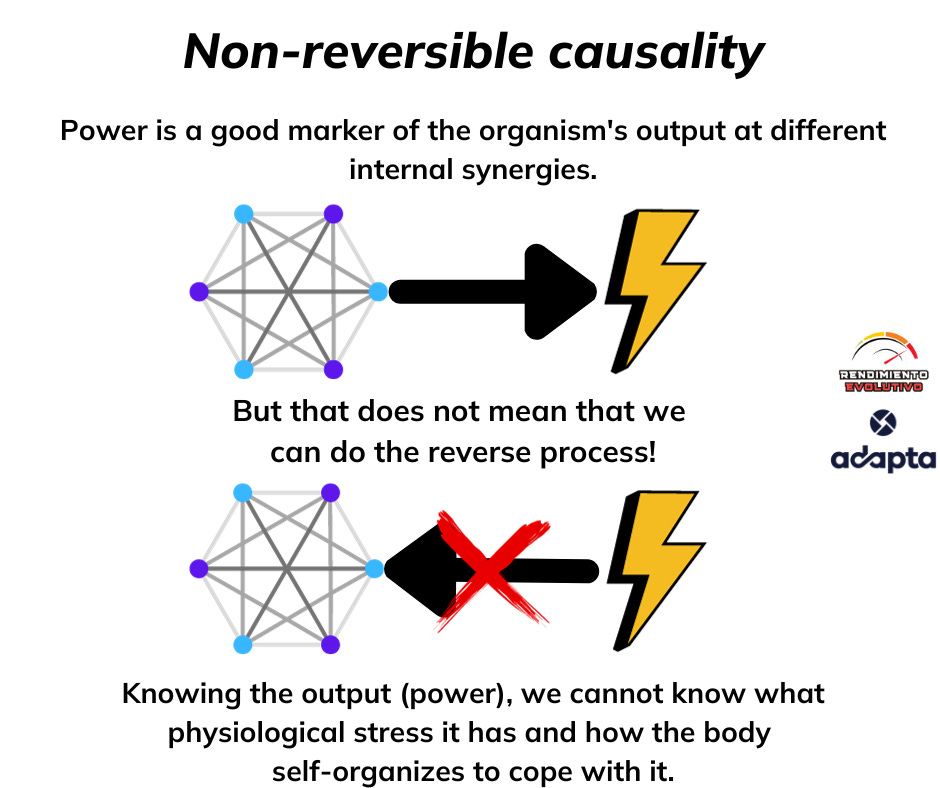Mechanics vs. Physiology
Mechanics are complicated. Physiology is complex.
Coaches find themselves in the middle of a crucial dichotomy between two currents: the mechanical and the physiological. Historically, the approach to training from a purely physiological perspective has been dominant. In the mid-20th century, it was easier to measure an athlete's lactate than their pedaling power. Therefore, the training approach was based on the evolution of physiological parameters such as lactate and oxygen consumption.
In recent decades, with the emergence and especially the popularization of power meters and precise GPS watches, a new branch of training has emerged, more mechanical, more based on external load, on the work that the athlete is capable of generating. This more mechanical approach has rapidly gained popularity since the publication of the book "Training and Racing with a Powermeter" in 2006, as power data provide us with information and functionalities as coaches that we did not have before.
And there is nothing our prehistoric brain likes more than the sense of control that working with exact data in areas previously dominated by uncertainty gives us, allowing us to believe we are doing "science" when we are simply applying heuristics and predefined templates.
It is natural for athletes and coaches to be dazzled by the application of a mechanistic approach to sports training, which allows us to work with the organism as if it were a mathematical problem. The problem is that we are applying mechanical engineering to Complex Systems, which do not respond as if they were a programmed robot.
The mechanical approach proposes trying to replicate the efforts and volumes the athlete must perform in competition with the idea that the organism will improve specifically guided towards replicating the watts they produce in training, and that by simulating the competition demands (in watts), we will be better prepared for it.
On the other hand, the physiological approach advocates that it is the physiological demands of the competition that we need to consider when training, not the watts. Therefore, it focuses more on training the different physiological milestones that it can measure (lactate threshold, FatMax, Vo2max, etc.).
In the following table, I explain how different training currents address some vital questions and how I would do it through a Complex Systems approach.
Examples
“Pedaling Technique”
Pedaling technique and its derivatives, efficiency and power, are one of the best examples of the war between physiological and mechanical approaches to training.
Mechanically, we can perfectly calculate the most efficient pedaling style: the one that minimizes radial forces in the pedal stroke. The problem is that our legs aren’t train cranks, and we’re much more efficient in some movements than others.
The mechanical view of training seeks to pedal in a way that minimizes wasted force in the pedal stroke. However, what’s found is that minimizing wasted force also worsens the ability to generate force, thus inhibiting performance improvement (Bini, 2024). Therefore, the view should integrate biology with physiology and seek the pedaling style that improves real performance (more watts), regardless of whether it improves or worsens pedaling efficiency metrics.
“Accumulating Time in Zone”
A common practice is to break down competition intensities into different zones and then train them separately. This mechanical practice ignores all dimensions of exercise physiology and assumes that 5 minutes in zone 4 are the same at the beginning or end of training, or are the same after 4 minutes all-out as after 4 minutes of recovery between sets.
“Adaptation Based on CTL”
Again, confusing correlation with causality. The body doesn’t adapt because you increase your CTL (Chronic Training Load) by 5% each week. The body adapts because you increase the stimulus.
This means that sometimes CTL can be lower and still improve more (when training in hypoxia, heat, or glycogen depletion, for example).
Also, CTL can increase while performance decreases if you’re unable to absorb the training (too hard efforts, lack of rest, poor nutrition, chronic fatigue, etc.).
For all these reasons, CTL seems to work well when starting training, as generally, the more you train, the more you stimulate; but this relationship is lost in well-trained athletes over many weeks/months.
Irreversible Causality
The main problem with the mechanical approach is that speed or watts aren’t directly proportional to the stress they generate on the body or the physiological structures and synergies activated to solve it.
Thus, extrapolating physiological effects from external load data always leads to errors that result in false assumptions and therefore incorrect training. They confuse the arrow of causality.
Just as people don’t become successful and then become hardworking – it’s the other way around – it’s not that watts produce specific physiological responses, but rather that a person’s physiology produces the watts.
Improving your level doesn’t mean you’ll always generate more watts, of course. Depending on the conditions (temperature, fatigue, hydration, motivation, etc.), your performance may vary, but what’s clear is that your watts improve because you improve, not because you apply mathematical laws of increasing training load or time in zones by a certain percentage.
Solution
We need to reconcile these two perspectives, or in other words: create work methodologies that integrate internal and external load to understand what is happening in the body, what effects it is having on performance, and where and how we can intervene to improve it.
The physiological approach is crucial because, ultimately, the body does not understand watts or TSS, but rather stress and stimuli. However, by only observing internal changes, we cannot know if the body is adapting, improving, and performing better or worse due to the factors we have discussed in previous chapters.
For this, we need the mechanical approach. Analyzing speed or power allows us to know the outcome of the body's self-organization and synergies. What will dictate that a synergy is more successful and that the body is improving is not that lactate levels are higher or lower, but that the watts or speed it can sustain for a given duration are higher.
At the same time, with only the mechanical approach, we will not be able to understand which points of the physiological network we can address or what is the best way to organize stimuli or design training to improve, because as I have mentioned, the body does not react to our WKO metrics but to all the aspects related to adaptation mentioned in the previous sections.
To unite these two fields, we will use physiological data to understand what is happening in the body and how to adjust training or rest, and mechanical data to understand what what is happening in the body means.
Here are some ideas, which I’ll develop in next emails:
Power/Speed Ratio – Perception of Effort
Dynamic Relationship between Power and Heart Rate
Evolution of internal load metrics when keeping external load constant session to session
Relationship between training load with external metrics and its effect on internal load through metrics like readiness, HRV, fatigue, and mood.
If you enjoyed this, you can learn more in my book, The Nature of Training.
I also have available training spots. Contact me at contacto@msa.training
See you next time!




